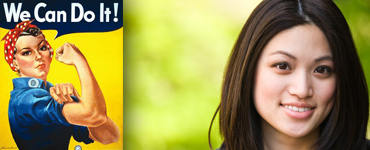ESL students struggling to create engaging thesis statements and develop argumentative essays may be blocked by the gap between existing and expected educational schema. Wolcott and Lynch’s 5-Stage method for developing critical thinking offers a route by which students can bridge these gaps.
Thesis-driven argumentative essays can be an excellent vehicle for introducing university-level English as a Second Language (ESL) students to academic conventions, research methods, and critical thinking skills. Many of these students, however, submit papers that look stylistically proper but lack an engaging thesis or argumentative development. One possible explanation for this issue centers on differences in educational schema – many ESL students come from educational backgrounds that do not emphasize critical thinking in the same ways that American universities do (McCargar, 1993). For ESL instructors tasked with preparing their students for future argumentative writing assignments, it can be difficult to create a scaffold that effectively bridges existing student schema and the critical thinking underpinnings of the argumentative genre.
Starting a schema-centered conversation, one that explores both the thinking assumed by thesis-driven argumentative essays and the possible interpretive frameworks that ESL students bring to the classroom, can help to prepare these students not just for argumentative writing assignments, but also for the many academic discussions, debates, presentations, and research projects they are likely to encounter in their university careers.
The Argumentative Essay as a Gateway
The thesis-driven essay is steeped in the liberal arts tradition, an educational schema that emphasizes both critical thinking and participation in democratic government (Brint, Riddle, Turk-Bicakci, and Levy, 2005). American leaders like Thomas Jefferson (1816; as cited in Kaminski, 2005), Woodrow Wilson (1909), and Dwight D. Eisenhower (1953) have extolled the virtues of a citizenry trained in discerning thought and have also pointed to education as a means of achieving that end (Kaminski, 2005). Although Barack Obama placed emphasis on the Science, Technology, Engineering, and Math (STEM) fields in a 2014 speech (Jaschik, 2014), and Donald Trump has questioned funding for the arts and humanities (Nossel, 2017), the idea of the liberal arts mindset as a necessary companion to STEM and business majors is still very much in play (Dekat, 2017; Gaposchkin, 2015; Klebnikov, 2015). At some point in their university careers, ESL students are very likely to encounter this thesis-oriented, liberal arts element of the American educational landscape, whether it be in their major, a general requirement, an elective, or an honors capstone project. As a manifestation of liberal arts thinking, the thesis-driven essay has the potential to act as a gateway into that educational schema.
Considering ESL Student Schema
For many ESL students, however, the liberal arts mindset is not a key piece of their educational background. Currently, according to the Institute of International Education’s (IIE) Open Doors Report (2017), 50 percent of international students coming into the United States are from China (33%) and India (17%). Many of these students, and others from nations with a non-Western educational schema, may be trained in a classroom atmosphere that can be more authority-focused and place less emphasis on critical thinking as practiced in a liberal arts setting (Aaron, 2016; McCargar, 1993). The IIE (2017) further notes that these international students are heavily favoring business and STEM majors. These factors – educational background and area of concentration – suggest a general trend away from the humanities and the liberal arts, and therefore a lower level of familiarity with the critical thinking techniques practiced there. This is not to say that critical thinking is absent from these educational environments or from business and STEM majors; a false demarcation between a liberally focused American classroom and an authoritarian Eastern one, or even a humanities classroom versus a business or STEM classroom, obscures complexity on both sides and hinders understanding more than it helps it (Kumaravadivelu, 2003). It is to say, however, that these students may require extra attention in developing critical thinking vis-à-vis the argumentative essay and other thesis-driven liberal arts practices such as presentations, discussions, debates, and other tasks of a similar nature.
Argumentative Essays as Evidence
ESL instructors can look to student writing itself for evidence that their students are struggling to produce thesis-driven essays or to develop critically thought-out arguments. Common types of essay challenges include what Bean (2011) refers to as ‘And Then’, ‘All About’, and ‘Data Dump’ essays. These essays either add information indiscriminately in a chronological or ongoing ‘story’ format (the ‘And Then’), attempt to include an overabundance of encyclopedia-like information without any real overarching thesis (the ‘All About’), or simply ‘dump’ information in the hopes that the reader will make some organizational sense out of it (the ‘Data Dump’). Taken altogether, problem essays such as these point to an issue with framing gathered information. Students may have found information but may not know how to think about what they have found. This is where an attempt at introducing a liberal arts / critical thinking perspective can prove useful. Given that schema govern the interpretation of input, a gradual introduction of critical thinking methods to the ESL writer seems advisable (McVee, Dunsmore, & Gavelek, 2005). In order to bridge existing student schema to the US educational schema, for example, there must be a process of constructing, testing, and adjusting (Derry, 1996). All students encountering new information need time to incorporate it into their worldview, but this is especially true for ESL students who are balancing new language, new methodologies, and new subject matter.
Five Stages and a Local Lens
When it comes to a gradual introduction to the liberal arts and critical thinking underpinnings of thesis-driven writing, WolcottLynch Associates Idea Paper #37 (Lynch & Wolcott, 2001) provides a five-stage treasure trove of scaffolded technique.
Stage 0
It begins at Stage 0, aimed at students who are focused on finding the ‘right’ answer and have trouble with grey areas, questioning experts, evaluating evidence, and examining conclusions. Stage 0 tasks include activities that place a low cognitive burden on students’ existing schema. Repeating, paraphrasing, summarizing, describing, and listing all work with the desire to find the answer while still getting the student to process arguments (Lynch & Wolcott, 2001). The open nature of the staged framework also allows ESL instructors to flavor the process however they see fit. A grounding in local issues, for example, can be provided by selecting op-ed pieces from the local newspaper. While there are complex articles in any op-ed section, there are usually also a number of short and simply reasoned topical arguments. For example, an instructor working from the Duluth News Tribune in 2017 might have seized upon the controversy surrounding the Lake Superior and Mississippi Railroad (LS & MR) which was, at the time, much discussed in the paper. The thread of the argument could have been picked up in any number of pieces, including the opinion piece Save Mud Lake Causeway, Scenic Train (Hillmer, 2017). Like many such articles, it illustrates a simple local argument with low linguistic demand – of 292 total words in the piece, 92% fall within the 3,000 most common words in the English language (as measured using Compleat Web VP, an online program which scans text and analyzes it for word frequency).
Stage 1
Once students have picked up the thread of an argument, they can move to Stage 1 activities and begin stacking supporting evidence. As they gather new sources, students can be directed to explore them (Lynch & Wolcott, 2001).

An excellent companion to this process are guides that direct learners to focus on the quality of the evidence and the credibility of authors. This can involve modeling the investigation of sources with worksheets like the Argument Guide or the Credibility Guide to help students look at the types of support used to back a conclusion, whether there is preponderance of fact or opinion, the expertise of the author, and the amount of corroboration (Fisher, 2011; Pattison, 2015). This can all still be presented in terms of finding ‘right’ answers – for example, an author either does or does not have expertise, and facts are either used or they are not. If op-ed pieces from the local newspaper were used in Stage 0, students could also look on or around the same date to other op-ed pieces and news articles on the same topic. Continuing with the example of the instructor working with the Save Mud Lake Causeway, Scenic Train (Hillmer, 2017) op-ed piece from the Duluth News Tribune, an instructor could then introduce related articles on the same topic. For instance, LS & MR Faced with a Proposal from Duluth that Would Shorten their Route (Matt, 2017) appeared on the KBJR6 site and Endangered Railroad: The Lake Superior & Mississippi (Isaacs, 2015) appeared on the Heritage Rail Alliance site. Both articles added to the stance of the original op-ed article by underscoring the danger to the railroad and adding support for its preservation, thus allowing students to collect evidence in favor of their initial understanding of the issue.

Stage 2
As students gather research (either independently or instructor-led, as the case may warrant) and try to stack evidence in support of the initial argument they read, it is also helpful if they can either find different perspectives or if the instructor can introduce them. Fortunately, the op-ed section of most local newspapers is fertile ground for contrasting opinions on issues of the moment. The dissonance inherent in these differing views can be used to move students into Stage 2 activities, where they can be asked to present and compare different sides of the issue. That comparison also lends itself to a discussion of bias (Lynch & Wolcott, 2001). Again, guidelines like those provided in the Argument Guide and the Credibility Guide can be used to help students as they begin to explore what bias means. They can be directed to look at how balanced the coverage is in a particular source, whether or not generalizations are made, and if extreme language is present (Fisher, 2011; Pattison, 2015).
With source quality becoming more of an issue, students can also choose, or be helped to choose, better sources. The Lake Superior and Mississippi Railroad issue, for example, was part of a controversial environmental clean-up of the St. Louis River that involved local history, political disagreements, tourism issues, and environmental concerns. Addressing the larger context of the issue, as in this case, was a gateway to more serious research and to higher-value sources like the EPA’s Spirit Lake Legacy Act Cleanup (EPA, n.d.) and the MPCA’s St. Louis River Area of Concern Sediment Cleanup Sites (MPCA, n.d). Many local issues will lend themselves to such higher-value research. For example, a controversy over a grocery store’s decision to stop offering plastic bags could lead to wider research on pollution and climate change, and an op-ed controversy over all-terrain vehicles on roads could segue into research on tourism or road safety. Most issues appearing in the op-ed sections of local papers will have a wider context that instructors can use to advantage.
Stages 3 and 4
The conclusion of this process can be found in Stage 3, where students are able to use the evaluative techniques they have practiced to reach reasoned conclusions, and also in Stage 4, where they are better able to appreciate the ongoing nature of a knowledge-building academic argument (Lynch & Wolcott, 2001). In the case of the Mud Lake Causeway, it becomes harder for students to say whether historical import and tourism outweigh environmental and budgetary concerns, but when they do pick a side, they have been through the material extensively enough to know why. And this is a key feature of the five-stage process that WolcottLynch Associates have laid out – the gradual, scaffolded nature of the process forces students to take a granular approach to a given topic. Their journey becomes their argument, and this in turn can become their essay.
Conclusion
It is sometimes easy to forget that ESL students may be struggling with far more than language when they make the shift from the educational schema of their home culture to the educational schema of the United States. Many of the tasks that these students are asked to invest themselves in – argumentative essays, discussions, debates, and presentations – tacitly assume a familiarity with liberal arts values and critical thinking which may not be in place. In this sense, problematic argumentative essays that lack well-developed thesis statements or cohesive arguments can serve a diagnostic function – they can alert instructors to the need for a more scaffolded introduction to the liberal arts / critical thinking mindset underlying such assignments. The Wolcott and Lynch 5-Stage method for developing critical thinking can be a useful tool for such scaffolding – it provides guidance for a wide range of levels, can be easily segmented, and lends itself well to increasing student familiarity with local culture. Best of all, student success can be as simple as a lower incidence of problematic argumentative essays and as complex as a deeper appreciation and application of the schema underpinning American liberal arts practices. Regardless of where ESL students start in the process, they will find tools that will enable them to better understand and participate in their adopted educational community.
References
Aaron, S. (2016, June 26). Can India have a future without critical thinkers? Hindustan Times. Retrieved from https://www.hindustantimes.com/analysis/can-india-have-a-future-without-critical-thinkers/story-0fkofaGoIj7Rtjsd1EJCcM.html
Bean, J. (2011). Engaging ideas (2nd ed.). San Francisco: Jossey-Bass.
Brint, S., Riddle, M., Turk-Bicakci, L., & Levy, C. (2005). From the liberal to the practical arts in American colleges and universities: Organizational analysis and curricular change. The Journal of Higher Education, 76(2), 151-180. Retrieved from http://www.jstor.org/stable/3838721
Complete Web VP. (n.d.). Retrieved May 5, 2018, from https://www.lextutor.ca/vp/comp/
Dekat, K. (2017). Liberal arts vs. STEM: Does it have to be one or the other? Retrieved from https://www.researchgate.net/publication/319099976_Liberal_Arts_vs_STEM_Does_it_have_to_be_one_or_the_other
Derry, S. (1996). Cognitive schema theory in the constructivist debate. Educational Psychologist, 31(3/4), 163-174.
Eisenhower, D. (1953). Address at the inauguration of the 22d president of the College of William and Mary at Williamsburg. The American Presidency Project. Retrieved from http://www.presidency.ucsb.edu/ws/index.php?pid=9850
EPA. (n.d.). Spirit Lake Legacy Act Cleanup. EPA. Retrieved from https://www.epa.gov/st-louis-river-bay-aoc/spirit-lake-legacy-act-cleanup
Fisher, A. (2011). Critical thinking. Cambridge: Cambridge University Press.
Gaposchkin, C. (2015, November 5). Here are some more reasons why liberal arts matter. Dartmouth Engineer Magazine. Retrieved from https://engineering.dartmouth.edu/news/here-are-some-more-reasons-why-liberal-arts-matter
Hillmer, D. (2017, October 20). Reader’s view: Save Mud Lake causeway, scenic train. Duluth News Tribune. Retrieved from http://www.duluthnewstribune.com/opinion/letters/4347006-readers-view-save-mud-lake-causeway-scenic-train
Institute of International Education. (2017). Open door 2017 fast facts. Institute of International Education. Retrieved from https://www.iie.org/Research-and-Insights/Open-Doors/Fact-Sheets-and-Infographics/Infographics
Isaacs, A. (2015, March 7). Endangered railroad: The Lake Superior & Mississippi. Heritage Rail Alliance. Retrieved from http://www.atrrm.org/blog/2015/03/endangered-railroad-the-lake-superior-mississippi/
Jaschik, S. (2014, January 31). Obama vs. art history. Inside Higher Ed. Retrieved from https://www.insidehighered.com/news/2014/01/31/obama-becomes-latest-politician-criticize-liberal-arts-discipline
Kaminski, J. (Ed.). (2005). Citizen Jefferson. Lanham, MD: Rowman & Littlefield.
Klebnikov, S. (2015, June 19). Liberal arts vs. STEM: The right degrees, the wrong debate. Forbes. Retrieved from https://www.forbes.com/sites/sergeiklebnikov/2015/06/19/liberal-arts-vs-stem-the-right-degrees-the-wrong-debate/#720fbf0c7bbe
Kumaravadivelu, B. (2003). Problematizing Cultural Stereotypes in TESOL. TESOL Quarterly, 37(4), 709-719.
Lynch, C. and Wolcott, S. (2001). Idea paper 37. WolcottLynch Associates. Retrieved from https://www.ideaedu.org/Portals/0/Uploads/Documents/IDEA%20Papers/IDEA%20Papers/IDEA_Paper_37.pdf
Matt, A. (2017, June 29). LS & MR faced with a proposal from Duluth that would shorten their route. KBJR6. Retrieved from http://www.kbjr6.com/story/35783490/lsmr-faced-with-a-proposal-from-duluth-that-would-shorten-their-route
McCargar, D. (1993). Teacher and student role expectations: Cross-cultural differences and implications. The Modern Language Journal, 77, 192-207.
McVee, M., Dunsmore, K., and Gavelek, J. (2005). Schema theory revisited. Review of Educational Research, 75(4), 531-566.
MPCA. (n.d.). St. Louis River Area of Concern Sediment Cleanup Sites. MPCA. Retrieved May 5, 2018 from https://www.pca.state.mn.us/waste/st-louis-river-area-concern-sediment-cleanup-sites
Nossel, S. (2017, January 26). Donald Trump’s assault on the Enlightenment. Foreign Policy. Retrieved from http://foreignpolicy.com/2017/01/26/donald-trumps-assault-on-the-enlightenment-nea-neh-funding-cuts/
Pattison, T. (2015). Critical reading. Montreal: Pearson.
Wilson, W. (1909). The meaning of a liberal education. High School Teachers Association of New York, 3, 19-31.







